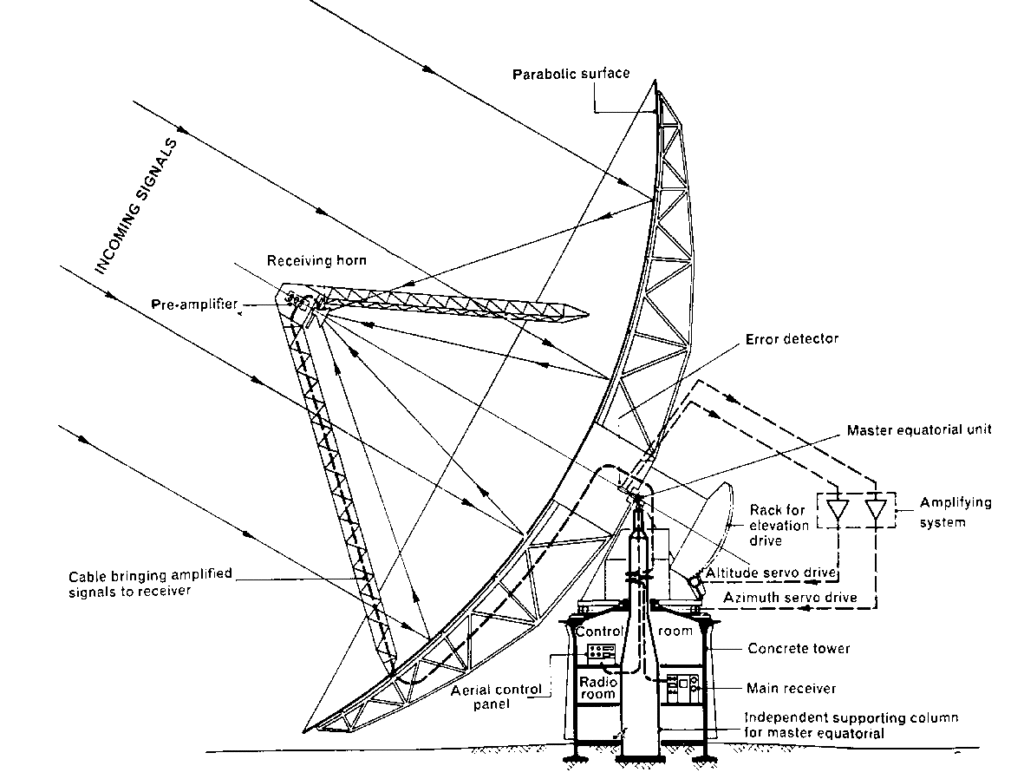Humanity’s most significant collaborative achievement started with, then Director of the Parkes Observatory, John Bolton, who did an official one-line contract with NASA: “The (CSIRO) Radiophysics Division would agree to support the Apollo 11 mission”.
In 1966, NASA made a proposal to include Parkes 64 meter dish in its international network. NASA did complete a 64-meter dish at Goldstone, California, but due to cuts in the budget, they postponed the second and third parts of its 64-meter network in Spain and Australia. They all were supposed to be modeled on Parkes Telescope. Now, they had to opt for Parkes as an alternative for their work.
Later, in October 1968 John Bolton, the director of Parkes Observatory was convinced by Eb Rechtin of NASA’s Jet Propulsion Laboratory (JPL) to collaborate with NASA for Apollo 11 Mission; the nature and severity of the mission that human lives were at risk in space made it vivid that it’s possible and should be.

After the final decision of early 1969, that NASA owes people to see the historic landing and visuals of the moon, it was decided to include a TV camera on the mission to show the world what’s happening.
Now, it was more wishful to have Parkes included in the mission, as they had the telescope with such a large collecting area (dish size), the extra signal receiving strength from the Moon. The astronauts had the burden of installing a 3-meter S-Band antenna on the moon. But, the specific timely-schedule as planned by NASA was not in favor of allotting 20-45 minutes for it. So, instead, they had to use a 0.66-meter S-band antenna already attached with the Lunar Module stage, which had to be connected with Parkes to have extra gain in signal strength. NASA had planned to have Neil Armstrong’s photos be stepping-foot on the Lunar surface, which obviously wasn’t possible before he could install an erectable S-band antenna. At this moment, Parkes was the most reliable, powerful quality and straight option, which was demanded by the planners of the Apollo.
The characteristics of Parkes telescope are designed to receive radio signals from the sky at a sidereal rate. Its maximum movable coordinates in azimuth and elevation are around 25o/min and 10o/min. It’s very significant if used for deep-sky objects at near sidereal rates, making it a great bet for the Apollo 11 Mission.

The historic words were said by Neild Armstrong, “One small step for a man, one giant leap for mankind,” and it was taken at time: 12.56 pm AEST on Monday, July 21, 1969.
This grand endeavor was watched all over the world by 600 million people, i.e. 1/5th of the global population, and it was all made possible due to this grand-collaboration. Two other stations were also working side by side with Parkes Radio Telescope, the Honeysuckle in Canberra, and Goldstone in California.

When NASA was trying to judge the quality of broadcasting they remained with Parkes TV pictures, as it was superior from both other signal stations, and all the signals were being transferred to Mission Control at Houston. So, NASA continued using the quality for the 21/2 hour telecast live for the Global Audience.
At morning 6.17 AEST on July 21, the Apollo 11 Mission landed their LM Eagle, on the sea of Tranquility within the space of a few hours that were needed for the moon to be positioned at an exact spot that can be witnessed from the Parkes Telescope.
In the meantime, the astronauts took some rest before the legendary Moonwalk. However, Armstrong changed his mind from the planned moonwalk.
The schedule required the astronauts to rest before attempting the moonwalk, by which time the Moon would have been high overhead at Parkes. However, Armstrong departed from the original plan, opting for an immediate moonwalk instead. Still, the preparations took time and the moonwalk was simultaneous at the time when the moon rises over Parkes.

Great missions come with greater challenges. One such moment was when the telescope was struck by a series of high-speed winds of around 110 kph, which made the entire operation shudder. It was being slammed against its zenith axis, the entire showdown was in jeopardy and hazardous for the structure of the entire machinery. Fortunately, the winds stopped and Astronaut Buzz Aldrin activated the camera while the moon was up within the telescope’s reach and signal reception began.
The vigilant staffer of Parkes, Neil Fox Mason was not allowed to see the incoming photos on the TV, while continuously driving and controlling the telescope with dedication for the integrity of the successful mission, just in case winds start blowing again or signal reception gets interrupted.

Two places were receiving the signal; the first was the Australian Broadcasting Commission in Sydney and the other was Houston for the global viewers. As the signal was traveling half of the world from Sydney to Houston by the INTELSAT Geostationary Satellite, a 0.3-second delay occurred, people in Australia saw the moonwalk 0.3 seconds earlier than the rest of the viewers globally.
This scientific collaboration of support and endeavor for the Apollo 11 Mission and sending a man to the moon inspires to show us the professionalism of CSIRO and NASA staff, combining efforts of so many organizations such as the Australian Broadcasting Network, the postmaster General’s Office, Astronomers, Technicians and all who were involved in to maintain the tiniest of details of the mission.
Also Read: OLDEST STAR-DUST DISCOVERED ON EARTH IN 2020

Fouz Siddiqui is a writer, academic and scientific management person. Presently, he is a Co-founder and Chief Information Officer at Scientia Magazine. As CIO, he oversees the implementation and strategization of Scientia’s technological and scientific vision. Concurrently, In academia, he holds a Lecturer and QM position at ATH – IST. As an academic, his research interests are Exoplanetary Sciences within Astronomy. Furthermore, he also works with Kainaat Studios, as its Manager of Science Outreach.

